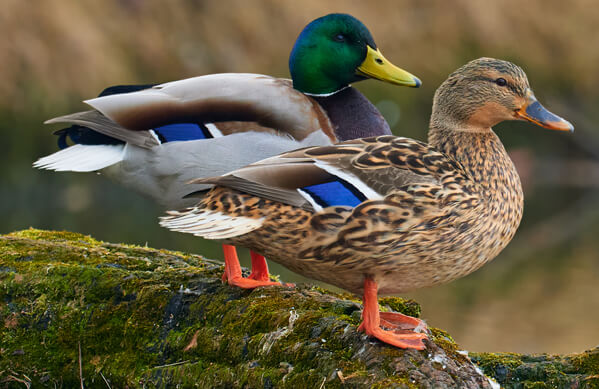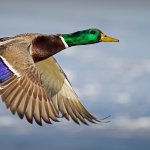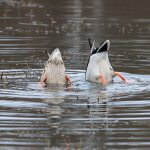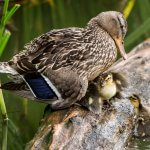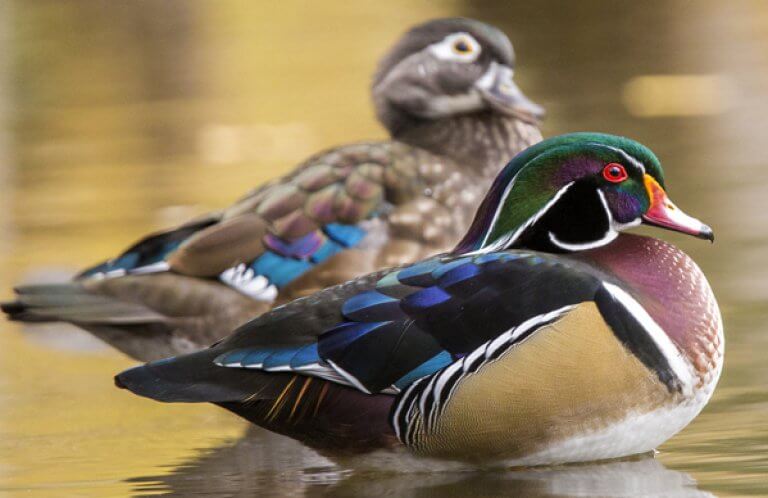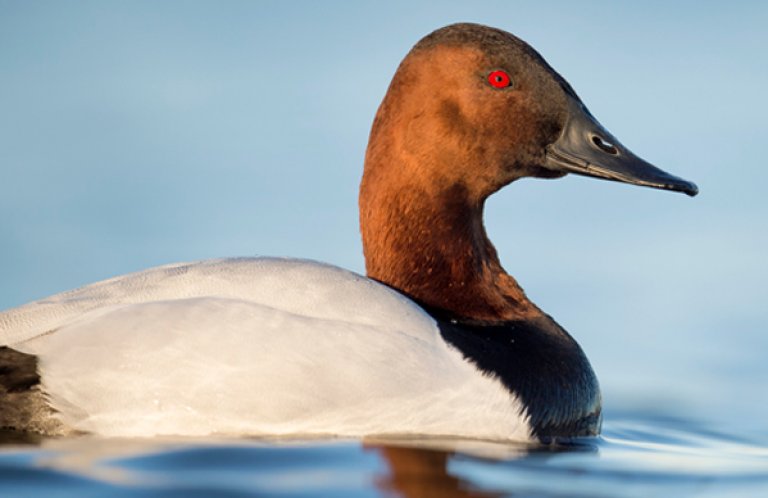About the Mallard
The Mallard is a familiar sight on ponds and lakes in many parts of the world, and many people readily recognize this bird. Only the male Mallard, or drake, has the glossy green head and white collar; the female (called a hen) is streaked and mottled in shades of brown, buff, and black. Both sexes have orange legs and feet and an iridescent blue wing patch on each wing that's edged in black and white, called a speculum. These patches are particularly noticeable as a Mallard springs into flight.
This quintessential duck is the progenitor of almost all domestic duck varieties, and will readily interbreed with them, producing a sometimes-puzzling array of hybrid ducks in a variety of plumages. Mallards also hybridize with wild ducks such as the closely related American Black Duck and Koloa or Hawaiian Duck. As discussed at the end of this account, this has sparked some daunting conservation challenges.
Songs and Sounds
If it quacks like a duck…It's actually a hen! Only the female Mallard makes the familiar "quack" call so strongly associated with ducks in general. This "decrescendo" call is a series of quacks that starts loudly and becomes softer. It's used to keep in contact with a mate or to communicate to the larger flock. Quacking tends to be contagious — once one hen sounds off, others in the flock usually join in.
Although the "quack" is her most familiar call, the female Mallard produces a variety of softer vocalizations, mostly when brooding and tending her young, which learn her call while still in the egg. The drake Mallard's call is a quieter, raspy note; he also produces a variety of grunts and whistles during courtship displays.
Unhatched Mallards produce a variety of sounds while still in the egg. These prenatal calls help the ducklings synchronize the timing of their hatching — ideally, all the eggs hatch within hours of each other so the hen can expeditiously lead her young to the safety of the water.
Listen to a variety of Mallard calls here:
(Audio: Nikolay Sariev, XC625685. Accessible at www.xeno-canto.org/625685 ) · Daniel Lane, XC46614. Accessible at www.xeno-canto.org/46614 )
Breeding and Feeding
Unlike larger waterfowl such as the Tundra Swan, which mate for life, Mallard pairs only stay together for a season. Courtship and pair formation begin each fall and winter. Groups of males display for a hen with a variety of behaviors, including head and tail shaking, head-bobbing, dipping, and whistling.
Once mated, the hen Mallard chooses a nest site, usually on the ground in a well-hidden, grassy area near the water. Her nest is a simple scrape, lined with any vegetation she can reach, along with a generous batch of her own soft breast feathers. Urban and suburban Mallard hens sometimes choose odd nesting sites such as flower planters, roadsides, backyard brush piles, and even rooftops.
A female can produce a clutch as large as 15 eggs; however, the average is around nine. Mallard hens, and those of many other waterfowl species, such as the Wood Duck, Canvasback, and Red-breasted Merganser, sometimes lay eggs in other females' nests, a behavior known as intraspecific brood parasitism, which is more commonly called "dumping." This behavior allows a female to lay more eggs than she could care for herself, and increases the chances that at least some of her genetic legacy gets passed on.
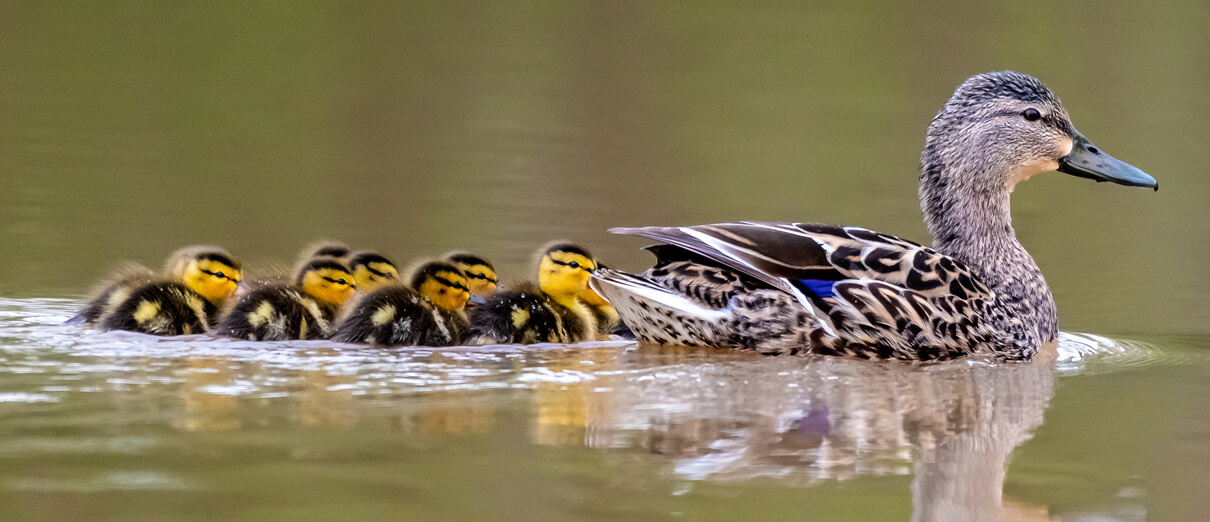
After the down-covered ducklings hatch, the female leads them out of the nest and to the water. The ducklings can swim and forage for food right away, although they remain with their mother for several months.
The Mallard's aquatic foraging style places it in the category of "dabbling" ducks. These waterfowl feed along the surface of shallow waters or by tipping headfirst into the water with rears and feet up and neck below the surface, grazing on aquatic plants or rooting along the bottom for aquatic tubers and insects.
The Mallard is an omnivorous and flexible feeder, which probably helps to account for the species' large numbers and wide distribution. Like many other waterfowl, it dines on aquatic vegetation such as tubers, rootlets, and seeds. It also feeds on land, taking insects, worms, small fish, and snails, and grain crops such as wheat and corn.
Region and Range
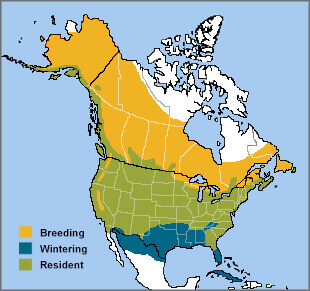
Mallards are widely distributed around the world. Wild populations occur throughout the Northern Hemisphere, including much of North America and Eurasia. Captive-raised Mallards have also been widely introduced not only within the traditional range but also in many parts of the world where the species never occurred before, making the Mallard truly the world's most widespread duck species.
Although some Mallard populations are sedentary, many are short- to medium-distance migrants, moving south along established flyways to warmer areas for the winter, and northward in spring to nesting grounds. They are prodigious flyers and can cover up to 800 miles during one night's eight-hour flight.
Conservation of the Mallard
Although the Mallard is a popular game bird, it remains the most numerous and successful duck species in North America. It can readily adapt to human disturbance, and it thrives in suburban and even urban areas.
Even though numerous, the Mallard can be affected by habitat loss. Its aquatic foraging style also increases its risk of ingesting lead shot, which can lead to debilitating or fatal lead poisoning. Mallards, along with other birds, may also suffer the effects of neonicotinoid pesticides as they forage for vegetative matter on land, and this duck and others have fallen victim to fatal oiling at unregulated energy facilities.
Wild Mallard populations have benefited greatly from the Conservation Reserve Program (CRP) and other grassland and wetland restoration efforts in the northern prairies of the United States.
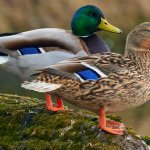
Help support ABC's conservation mission!
Hybridization with introduced/invasive Mallards is considered a threat to a number of declining duck species, including the American Black Duck and the recently split Mexican Duck. For Koloa, or Hawaiian Duck, which is considered Critically Endangered globally and listed as Endangered under the Endangered Species Act, the Mallard poses one of the leading threats to the species. There is some question as to whether any pure Koloa remain. On Oahu and Maui, especially, hybrids now dominate.
In addition, there is significant mixing of Mallards and Mottled Ducks in the southern U.S., with an estimated 7 to 12 percent of Mottled Ducks exhibiting evidence of hybridization in Florida populations, for example. These hybrids are fertile, so the problem continues with hybrids breeding in the population. In New Zealand, nonnative Mallards hybridize extensively with native Pacific Black Ducks and in some areas hybrids are more common than pure-bred Pacific Black Ducks.
Get Involved
Policies enacted by the U.S. Congress and federal agencies, such as the U.S. Fish and Wildlife Service, have a huge impact on America's birds. You can help shape these rules for the better by telling lawmakers to prioritize birds, bird habitat, and bird-friendly measures. To get started, visit ABC's Action Center.
Living a bird-friendly life can have an immediate impact on the birds around you. Doing so can be as easy as adding native plants to your garden, avoiding pesticides, and keeping cats indoors. To learn more, visit our Bird-Friendly Life page.
American Bird Conservancy and our Migratory Bird Joint Venture partners have improved conservation management on more than 6.4 million acres of U.S. bird habitat — an area larger than the state of Maryland — over the last ten years. This is a monumental undertaking, requiring the support of many, and you can help by making a gift today.





































